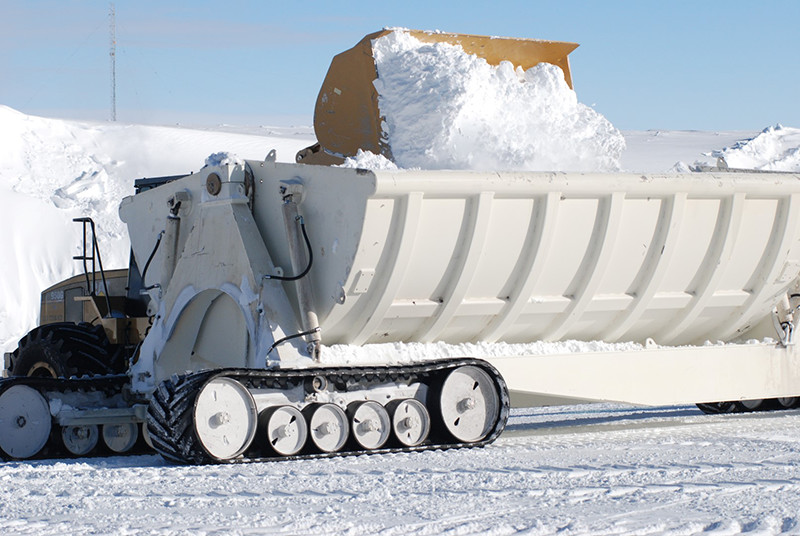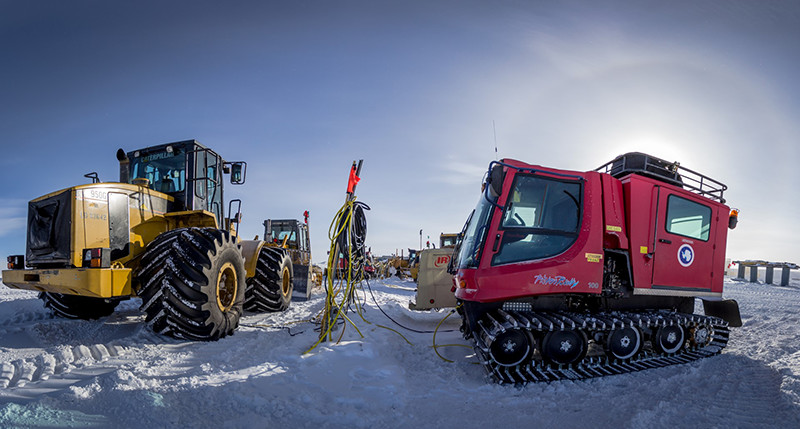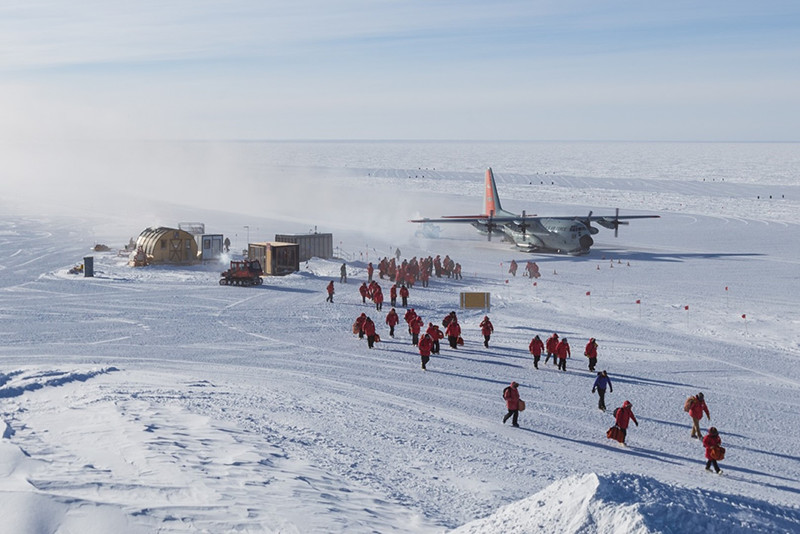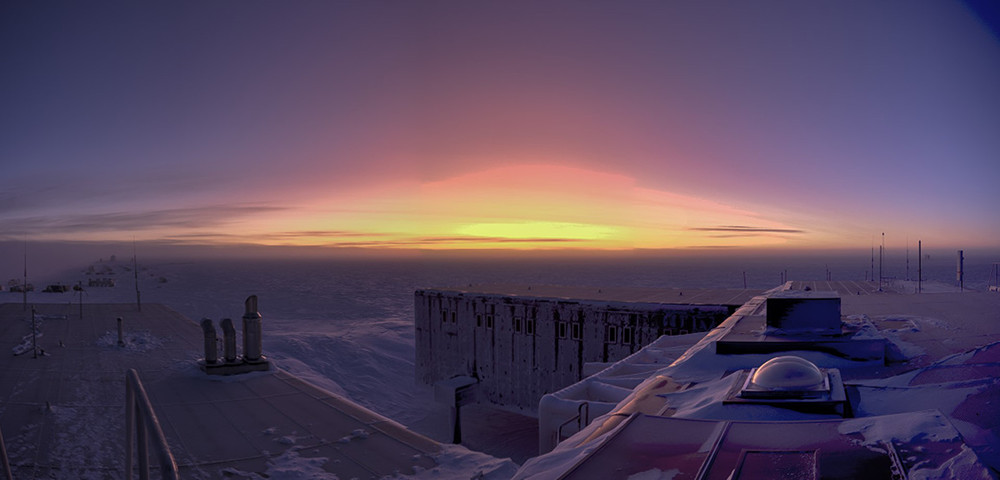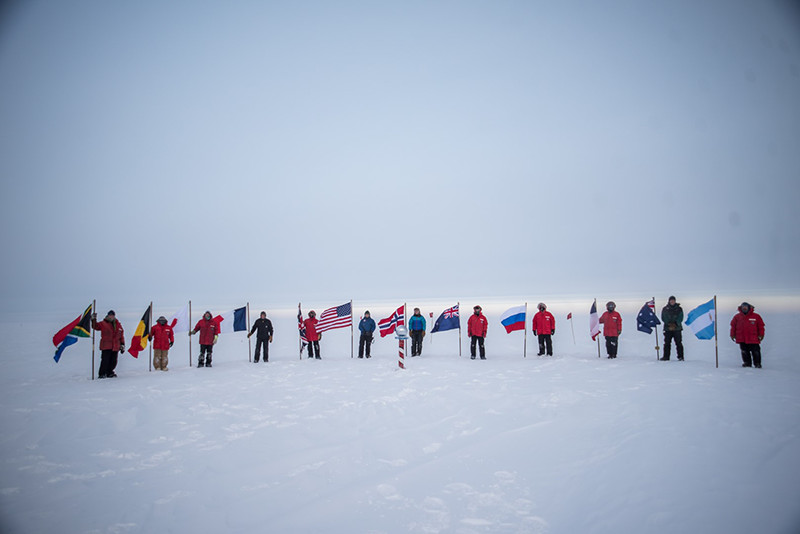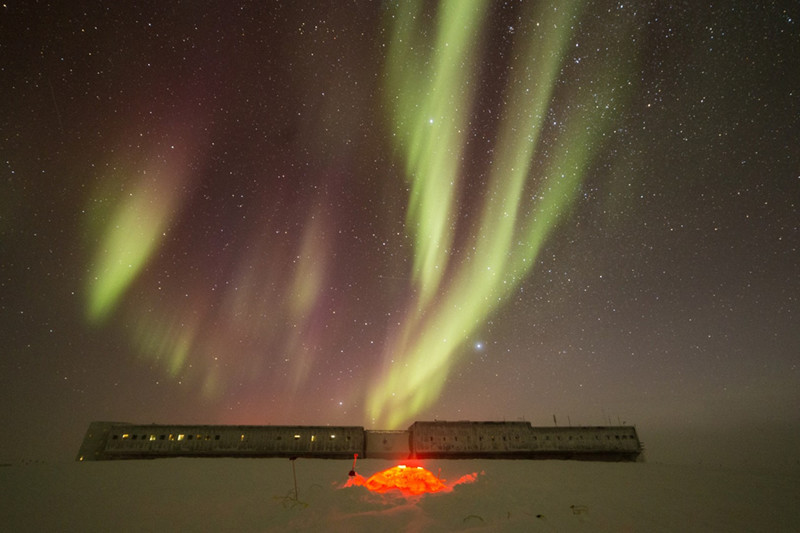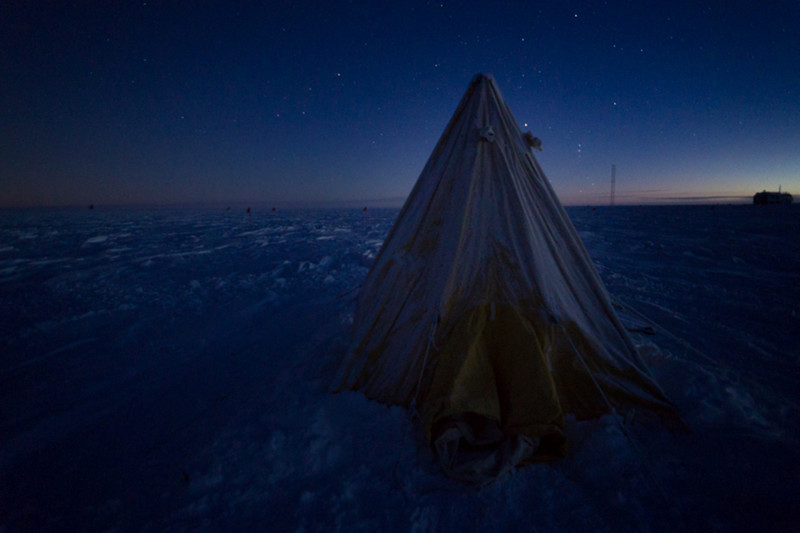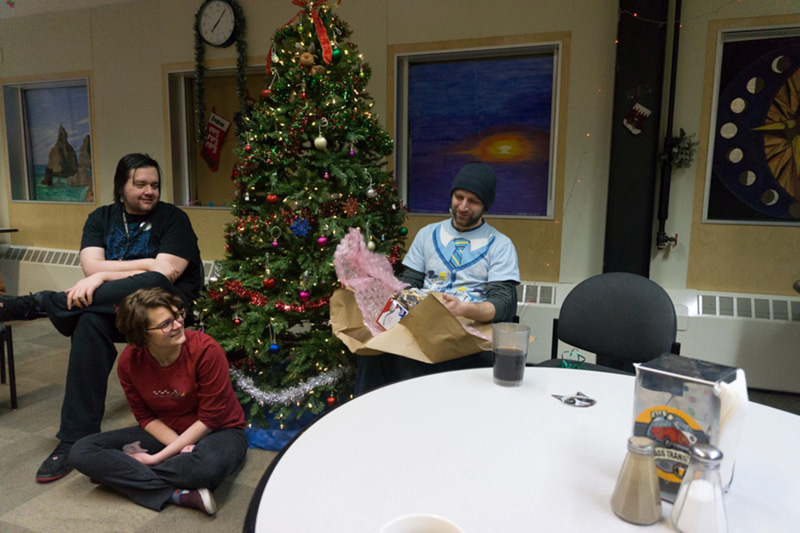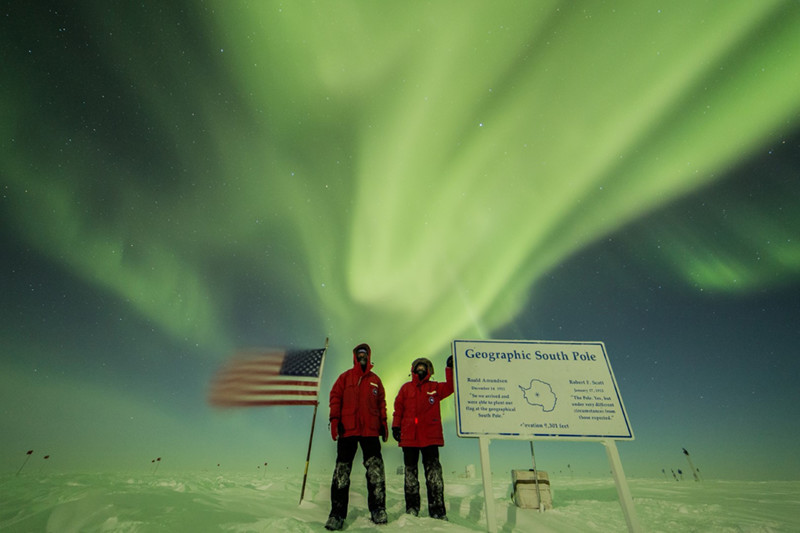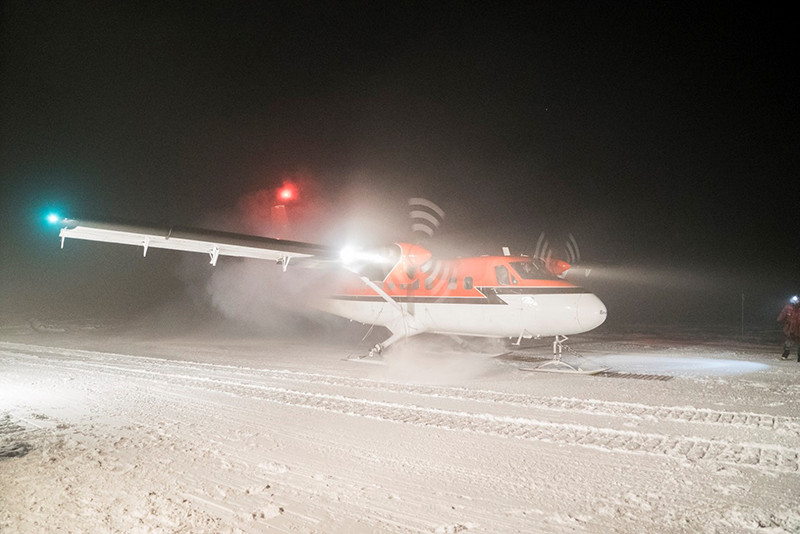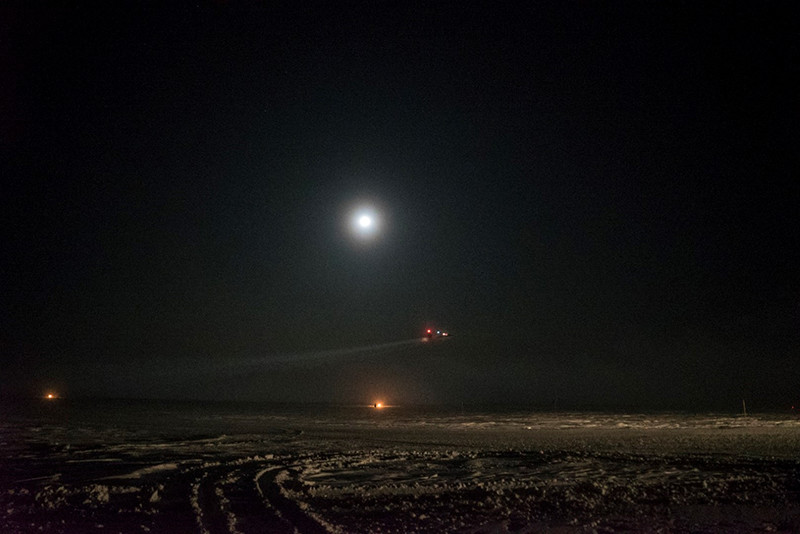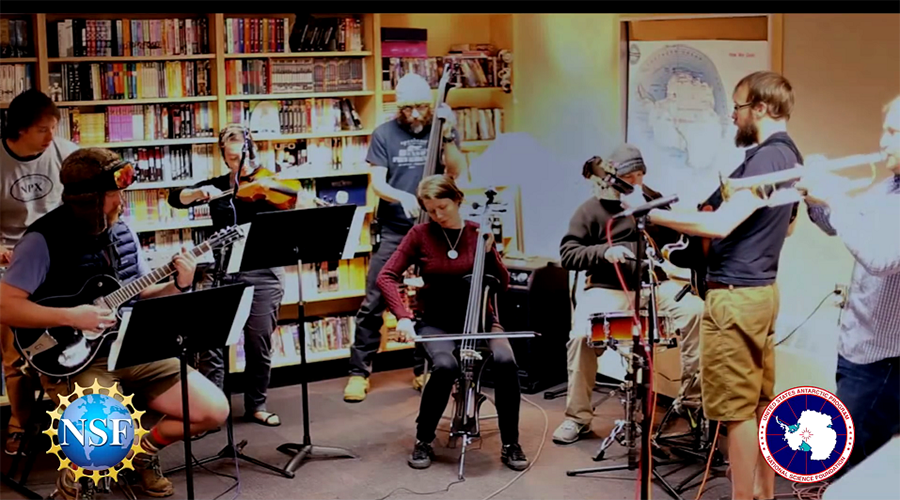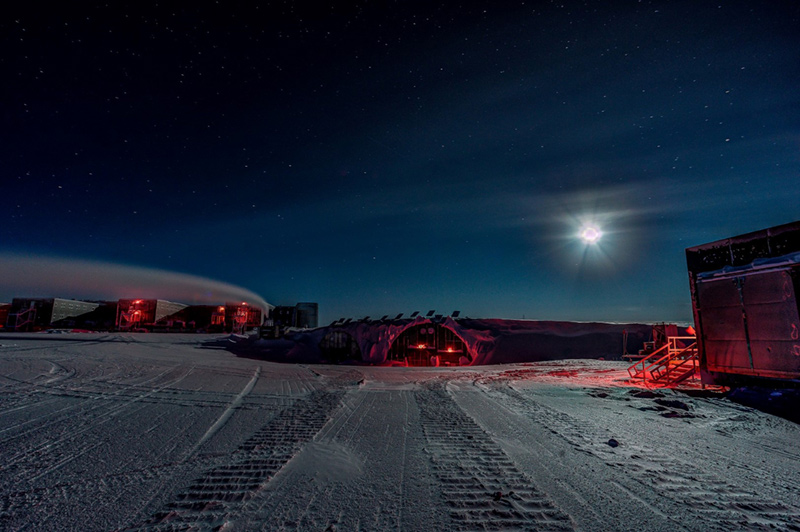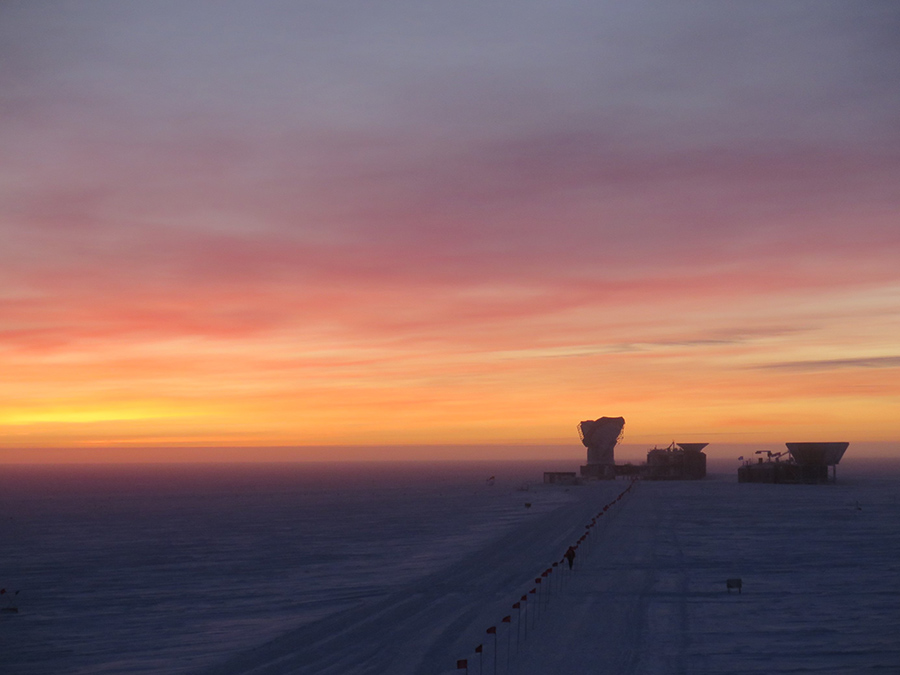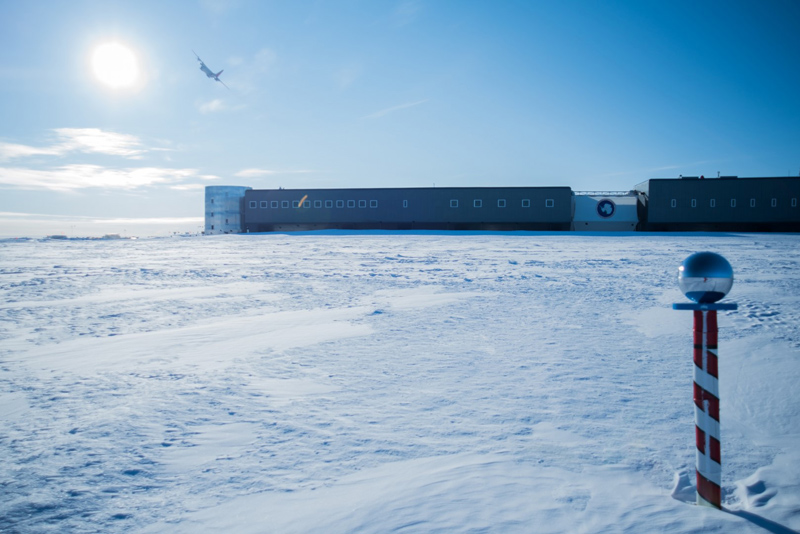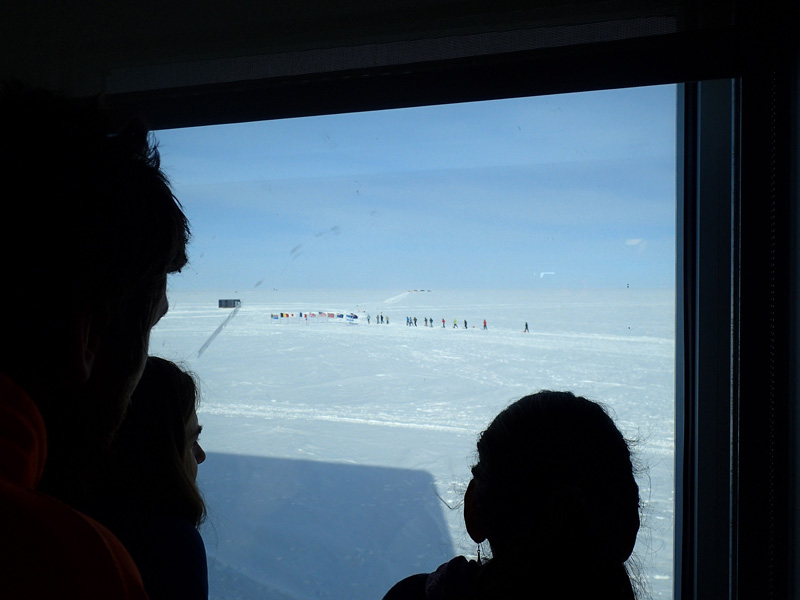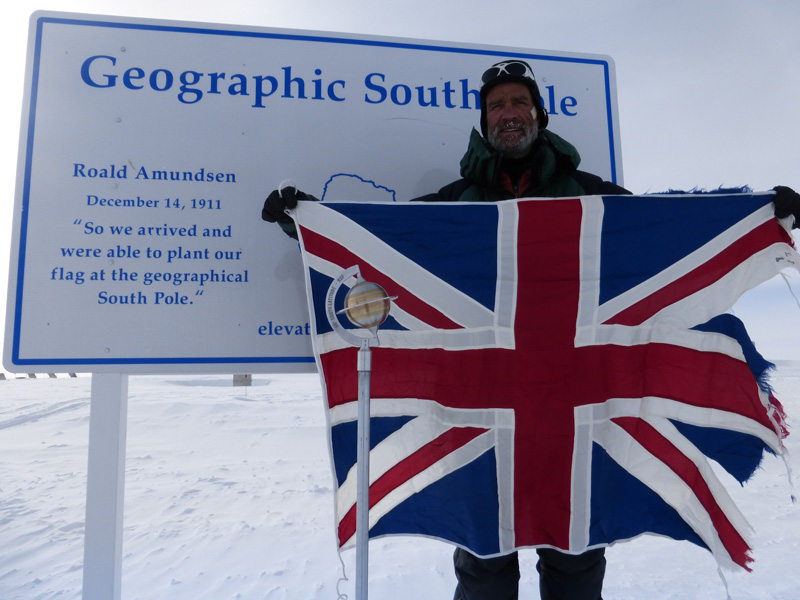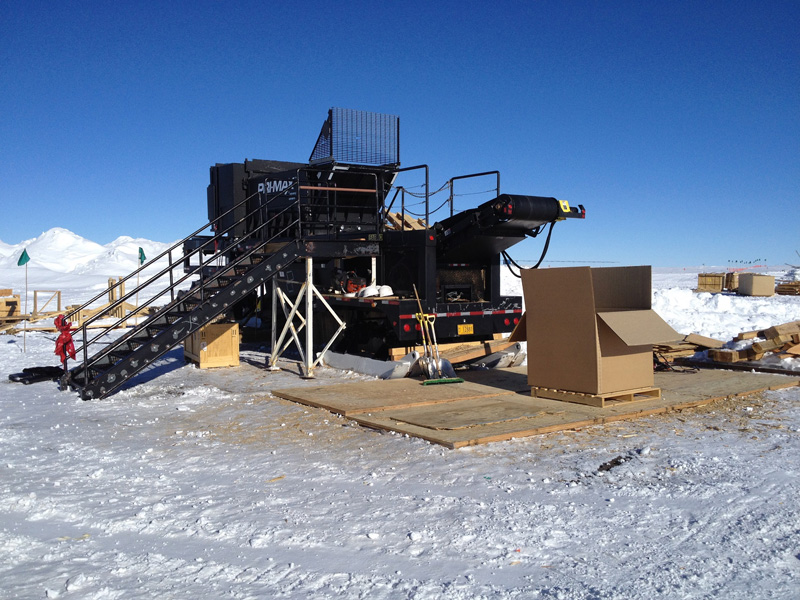|
South Pole Station Archives - 2016 Thanksgiving at the PoleDecember 12, 2016
The summer season is only four short months and there is much that needs to be accomplished before the station closes mid-February. With more flights coming in, the station population is now at 130, and the amount of work to do seems endless. A number of the science projects need to be upgraded, along with the regular summer maintenance required to prepare the station for the coming winter. One of the major ongoing projects is the clearing of the snowdrifts that accumulated around the station and outlying buildings over the winter. The heavy equipment operators are hard at work every day with bulldozers and front-end loaders removing snow so that snowdrifts from the coming winter don’t build up on the old drifts, which could be a hazard to the station. The 10-meter South Pole Telescope is slated for major upgrades during this summer season to better detect the Cosmic Microwave Background, which could lead to a better understanding of the origins of the universe. The South Pole Ice coring team returned this season to retrieve some ice cores that will be used for a number of projects to illuminate the history of the Earth’s climate. Two researchers from the Cold Regions Research and Engineering Laboratory (CRREL) are on station to deploy a new project that will attempt to sample cosmic dust and micrometeorites from the Antarctic air. The South Pole took a break from science and regular duties on Saturday, November 26 to celebrate Thanksgiving. The galley crew put together an amazing meal of turkey, gravy, stuffing, and numerous sides, while station personnel volunteered their time carrying in supplies, decorating the galley, washing pots and pans in the dish pit, or serving wine and other beverages. Summer Season Begins at PoleNovember 8, 2016
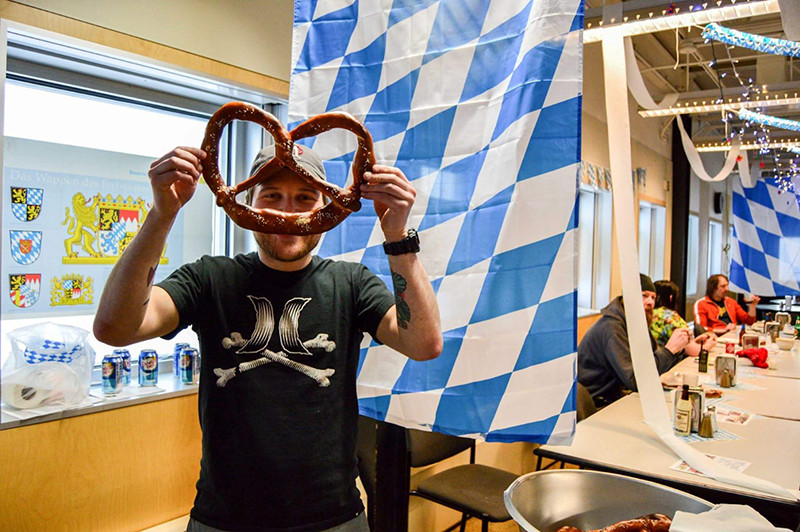
Photo Credit: Rachel Cook
Station residents were treated to huge homemade pretzels at the Oktoberfest celebration.
The month began with the celebration of Oktoberfest. Two German grantees who wintered with us helped put together an authentic party. The galley was decorated with streamers and flags, and we feasted on bratwurst, sauerkraut and huge pretzels. It was not exactly the same as being in Munich, but a pretty good approximation. October is also the month for putting the final touches on the skiway landing strip, and getting the station ready to receive guests. With the cold, dark months of winter and station preparations behind us, the South Pole Station is now ready for the first planes to arrive and begin the busy summer season. The first, a Basler that passed through the British Rothera Station, landed on October 11 and stayed just long enough to refuel before continuing on to McMurdo Station. Later that same day a Twin Otter, also from Rothera, arrived and the crew spent the night to rest. Weather delays kept the Twin Otter here for a couple of days before it was able to take off and travel to McMurdo Station. We then had a pause before the first flight from McMurdo Station arrived on October 27. That Basler brought in eight summer personnel and six wintering residents departed. It was great to see some new faces, and just as importantly, we received “freshies.” To be able to eat apples and oranges again has been incredible. We’ve been treated to a couple of fruit platters at meals, and the smell of fresh onions being cooked gets us salivating. We received our second Basler from McMurdo two days later – once again exchanging winter personnel for summer personnel. But the biggest change in personnel occurred on Nov. 2, when the first LC-130 of the summer landed, followed by another Basler. In that one day the station population nearly doubled from 56 to 98 people. There is no questioning it now, the summer season has begun at the South Pole. Sunrise at PoleOctober 3, 2016
September is a month of big changes at Amundsen-Scott South Pole Station, with the transition from darkness to light being the biggest of all. The last of the light-sensitive aurora cameras were turned off on August 31, allowing residents to take off the station’s window coverings. Because of the lingering darkness, we could only see our reflections in the windows at first. But as the bright sun rose we could start to make out the features sticking out of the Polar Plateau. Now the sun is fully up and shining through the windows as it circles around and around the station, just above the horizon. The first glimpse of the sun was witnessed by several people in the galley on September 7. It was still about six degrees below the horizon, but was visible due to a strong thermal layer which bent the light. On the same day we set a new low temperature record for the day of -107.5 degrees Fahrenheit, so any thoughts of the impending summer were tempered. Our last big celebratory dinner – the Sunrise Dinner – was held on Saturday the 24th. The galley crew did another fantastic job and treated us to a luau-themed meal including kalua pork with a ginger hoisin barbecue sauce, roasted salmon with a pineapple sweet chili glaze, and homemade pineapple sorbet made using liquid nitrogen. Although the food was great, the most excitement was in getting to see the new 2017 Pole Marker. Our machinist did a beautiful job and it will be well received when it is officially unveiled on New Year’s Day. Unfortunately, as tradition dictates, I cannot share any photos of it. Everyone else will just have to wait three more months to see it. With the sun up and flights scheduled to arrive soon, we have all switched into a higher gear to prepare for the upcoming flurry of activity. The ski-way is being prepped, the fuel pits are being assembled and snow has been shoveled away from entrances. The 12 national flags around the ceremonial pole have been put back in place. Inside, we are transforming our cozy winter home back to a station ready to welcome the huge influx of summer workers. Thoughts of travel and seeing friends and family again have helped wipe away the cobwebs of a long winter and given us the extra energy to make all necessary preparations. It will be hard to say goodbye to this station that has been our home for so long, but new adventures await. The Southernmost Science FairSeptember 1, 2016
August is the last full month of darkness at the South Pole. But rather than a month of low energy and predictable routines, it was full of activities and entertainment. In early August, several people decided to try their hand at building an igloo during their off hours. The surface snow here at Pole is too powdery to make good blocks, but with enough digging they were able to find snow that was compact enough to work well. It took a lot of effort and a solid week of work before it was completed, but it turned out great. When lit from the inside with a red light it glowed beautifully. The South Pole participated in the annual Antarctica Winter International Film Festival (WIFF) and we had a lot of fun creating our entry for the 48-Hour category where teams across the continent produce a short film in just two days. The added challenge was each entry had to incorporate the sound of an elephant trumpeting, a stethoscope, someone saying “May the force be with you,” a mythical creature and someone walking as if they are on a catwalk at a fashion show. Our entry was a spoof on a South Pole orientation video. When the WIFF was over, we held a screening of all the entries (22 entries in the 48-hour category and 14 open entries). It was quite entertaining to see what the other stations came up with. Congrats to all the stations for their creativity. The entertainment turned educational during a science fair held on Sunday the 21st. People had the opportunity to play with Oobleck – a non-Newtonian fluid made from corn starch and water. Its viscosity (or thickness) is increased with pressure, so moving your hand slowly through the mixture is quite easy, as if it were a liquid, but any sudden movement like slapping it or punching it and it feels hard like a solid. At another station, liquid nitrogen was also used to condense liquid oxygen out of the air. Magnets were then used to deflect the flow of the liquid, demonstrating its paramagnetic properties. The event was well attended and really put the fun into science. The month of August was rounded out with the annual South Pole Winter 8-Ball Pool Tournament. Twenty-eight of the station’s 46 residents participated in the week-long double elimination event. There were a large number of spectators for just about every game and good natured heckling added to the competition. With the month ended, we look to the light on the horizon in anticipation of the returning sun. It will be sad to lose the beautiful night skies with the brilliant stars and amazing auroras, but the sun will definitely be welcomed back after its six-month absence. South Pole’s Christmas in JulyAugust 9, 2016
On Sunday the 24th, the South Pole Station celebrated Christmas in July. Residents decorated the galley, set up a tree and, the night before, much of the station decorated Christmas cookies. Because Sunday is a day off for everyone, including the galley crew, volunteers got together to prepare a nice Christmas meal of turkey, mashed potatoes, yams, wild rice, a greenhouse salad and pumpkin pie. The wonderful meal, along with eggnog and “A Christmas Story” playing on the galley screens in the background, put everyone in the holiday spirit. A gift exchange rounded out the evening, and the whole event was a fun way to break up the monotony of our long winter. Although there is a fair amount of winter left, we will begin to see the sky lighten in less than a month as the sun nears the horizon. We are in our last two weeks of true darkness right now which will last until the moon rises again on August 7. By the time the moon sets on August 21, we will be able to see a glow on the horizon which will slowly get brighter and brighter until we finally see the sun again in late September. While everyone on station will welcome the return of the sun, we are enjoying our last good period of stargazing and observing auroras. We’ve had some amazing aurora displays in the month of July and those with good cameras have captured fantastic photos. It is with a touch of sadness that the station bid farewell to the GOES-3 satellite at the very end of June. The spacecraft was originally launched in 1978 as a weather satellite, and then was repurposed 21 years ago as a communications satellite for the South Pole. GOES-3 helped keep the South Pole Station in touch with the rest of the world throughout the years, and it will be missed. A Midwinter MedevacJuly 11, 2016

Photo Credit: Robert Schwarz
Numerous white-colored strobe lights and eleven 55-gallon barrels burning fuel to the left of skiway, light up the landing strip for the medevac plane with the South Pole Station off in the distance.
Midwinter at Pole was busier than usual. Two people needed to be flown off continent for medical reasons, a feat not attempted in years and never this late in the winter. Everyone was busy with preparations for it over the two weeks leading up to that. While the intense planning and coordination off-station was going on (preparing two Twin Otter planes and crews in Canada to make the long journey south is no small undertaking), we concentrated on our responsibilities. Buildings out at “the end of the world,” were dug out of the snow and pulled to the flight line. These included a warming hut, a generator and electrical building, a pump house and another building full of fuel lines. Fuel and power were connected to the buildings, making them fully operational. While that was happening, untold hours were spent dragging the skiway and fueling area while flagging both areas. To light up the skiway, eleven 55-gallon barrels cut down to about 14 inches high were filled with a mixture of jet fuel and gasoline. In testing we learned that 15 gallons of the fuel mixture would burn for more than seven hours. Besides preparing for the planned medevac, the Emergency Response Teams (ERT) also prepared for any incident either on the skiway or further from the station which could include a search-and-rescue operation. Amid all of this excitement, we found time to celebrate some time-honored mid-winter traditions. The kitchen staff prepared a fantastic Midwinter meal on Saturday the 18th featuring shrimp hors d’oeuvres and grilled bison strip steak. Following the meal we watched The Shining on the big screen in the gym. June 22nd was the day the medevac plane arrived. The eleven fuel barrels lining the skiway were lit using an acetylene torch (because of the cold temperatures, it took about 30 seconds each to warm the fuel enough to ignite) and five battery-powered white strobe lights marking the approach were turned on. The various ERT teams took up their positions and around 9:20 am the plane was sighted, it banked around to line up with the skiway, and landed. Upon touching down, portable lights were switched on at the fueling area and the plane taxied into position. Bamboo mats were placed in front of each ski and the plane pulled forward onto them to park – this prevented the skis from freezing down to the snow. The plane was unloaded and we were delighted to receive a box of apples, a box of oranges, and a box of tangerines. It has been several months since we’ve had fresh fruit here, and even in the -75F temperatures we could smell the produce. We were surprised with another treat – fresh baked sweets and a nice note from Rothera Station. We cannot thank the team at Rothera enough for their assistance with this operation, and the personal touch of sending along some goodies was heartwarming. After the flight crew got a little rest, the plane was loaded up and we said goodbyes to our two departing teammates. Although it certainly had its risks, the entire medevac operation went smoothly. A huge thank-you to the two flight crews who made it all look easy. Polar JazzJune 2, 2016
It is dark at the South Pole, and the station has settled into its winter routine. The sun has dipped down past 18 degrees below the horizon, the limit for astronomical twilight, so there is no denying it anymore – it is very dark outside. We do get some reflected moonlight for two weeks during each lunar cycle, but otherwise we are left with just the light from the stars. All the better for star gazing though. We’ve been learning a lot about what we’re looking at during a 14-week astronomy class here at Pole. One of our wintering scientists was kind enough to teach a Monday night class for the last three months. The class was well attended, and it was a great opportunity to get a deeper understanding about what is going on in the skies above us. The South Pole Station submitted a musical piece for the International Jazz Day event and the organizers were nice enough to feature it prominently on their website. We played Gershwin’s “Summertime,” which seemed appropriate given that we are isolated here at Pole for the six-month winter. Some video clips were added to our submission, all of which were taken during the summer here. But don’t let that fool you, there is no sun here, we won’t see the sun for another four months, and it is definitely dark outside. The musicians practiced hard and all deserve credit for the all work they put in into their performance. The full lineup (from left to right): Nick on keyboards, Kyle on guitar, Amy on violin, Tim on bass, Christine on cello, Chet on drums, Hans on guitar and Max on trumpet. The video Darkness Falls at the South PoleMay 4, 2016
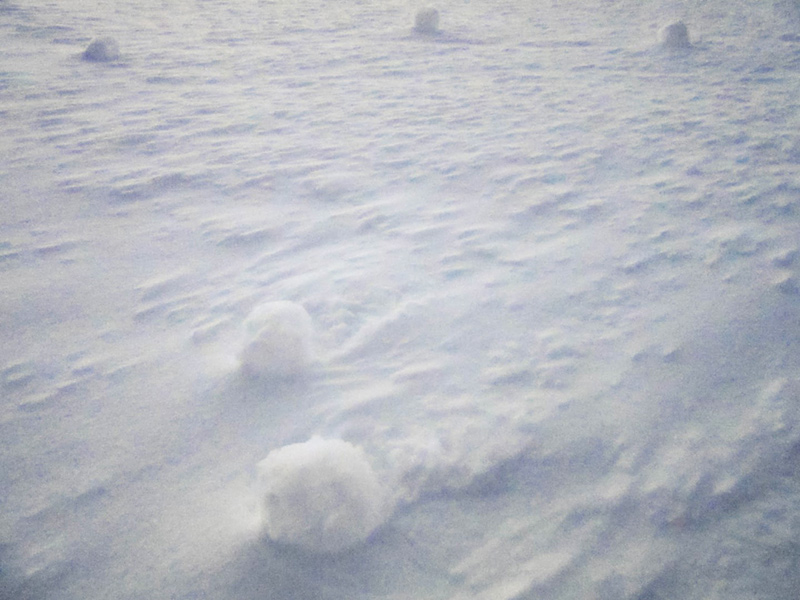
Photo Credit: Tim Ager
Under the right conditions, these Yukimarimo snowballs form from blowing wind around the station.

Photo Credit: Ethan Rudnitsky
A beautiful green aurora dominates the night sky over the South Pole Station.
April at the South Pole was our first full month of darkness. Early on, we were treated to a very cool phenomenon called Yukimarimo. Under the right conditions, these are little snowballs that form when the wind blows and bits of frost clump together. They are the Antarctic equivalent to tumbleweeds, but only about an inch or two in diameter. There was still enough ambient light to see them scattered about on the surface of the snow. The sun had just set at the beginning of the month, but now it is already 15 degrees below the horizon and contributes very little light to the night sky. There are a number of light-sensitive experiments here at the South Pole, so every effort has been made to eliminate light pollution from the station. All the windows have been covered and any outside lights are red. Eliminating excess light pollution is critical for the science, but it also enhances the amazing view of the night sky for everyone on station. Whether it is the moon, auroras, or the now-visible Milky Way, the night sky here at Pole is amazing. Residents have been clicking away with their cameras, capturing some amazing photos. For the majority of us not used to living in the Southern Hemisphere, it is fun to see the new constellations. Satellites are also commonly seen moving quickly across the sky, and the occasional iridium flare (the reflection of the sun off a satellite’s solar panels) adds to the show. Seeing auroras, however, is the biggest thrill. We’ve been quite lucky and have had a lot of aurora activity this month. The skies will get even darker on May 3 when the moon sets and we look forward to two weeks of moonless skies for optimum star and aurora gazing. One other space-themed highlight this month was the dance party on April 10 celebrating Yuri’s Night – two days early so as not to fall on a work day. Yuri’s night is a global celebration of humanity’s achievements in space. It is named after cosmonaut Yuri Gagarin, the first human to orbit the Earth. Many people showed up in costumes including flight suits, outfits representing constellations and a two-person, two-stage rocket contraption which was quite unusual. It was a fitting tribute and the celebrants danced the night away.
SunsetApril 1, 2016

Photo Credit: Rachel Cook
The setting sun behind the Ceremonial Pole, before the flags were brought in for the winter.
The light slowly faded as the month of March ended here at Pole, with the last direct rays of sunlight blinking out on Thursday, March 24, long after the equinox on the 20th. We had overcast skies for the three days following the equinox, and there was concern that the sun would disappear below the horizon without anyone seeing it go. But the weather cleared up beautifully on Wednesday night (March 23) and we were treated to a gorgeous sunset. Through a telescope that was set up in the galley, as well as through some good telephoto lenses, the elusive-at-mid-latitudes green flash phenomenon, when sunlight is refracted through layers of the atmosphere, was visible for several hours. Many residents stayed up late watching the sun on Wednesday night, knowing that after it was gone it wouldn’t be seen for a full six months. We were doubly lucky with the good weather, because as the sun was setting, a full moon began to rise. The sun and moon chased each other around the horizon before the moon finally won out. The last quarter of the moon is now dominating our sky, while the residual light from the sun continues to fade daily. Saturday March 26 was the start of a very full weekend. In the afternoon several of us gathered outside by the Ceremonial Pole to bring in the flags for the winter, with one person assigned for each flag from the twelve nations that signed the original Antarctic Treaty 1961. Later that evening the traditional sunset dinner was held, and the galley crew really outdid themselves with a special menu. The Cajun Imperial Rock Crab Cake hors d’oeuvres were amazing as were the Five Spice Seared Duck Breast and the Vanilla-Rum Poached Maine Lobster. Once dinner was cleaned up, many of us settled in to watch “30 Days of Night,” a vampire movie that takes place in Barrow, Alaska during their 30 days without sun. As we are just now heading into our six months without sun it was a very fitting choice. I am happy to report that as of now, there have been no sightings of vampires here at Pole. The following day, Easter, was celebrated with a good old-fashioned Easter Egg Hunt. Cadbury chocolate eggs were hidden all over the station and white snowmen Peeps were hidden outside the station. A clue sheet was emailed to everyone at 11 am, and we had the whole day to hunt down the treats. Even with the clues, the white snowmen Peeps were especially hard to find outside in the snow. It was a lot of fun and prizes were awarded to the top three teams. As if that wasn’t enough activity for one weekend, The Dark Sector held an Open House that day as well. Tours of the three Cosmic Microwave Background telescopes and of the IceCube Lab were fun and informative. It was quite a weekend to wrap up the month of March. Last Plane OutMarch 4, 2016

Photo Credit: Chet Waggoner
Station residents hold a party in the galley to watch a taped copy of the Super Bowl.
February was a month of transition at the South Pole station. When it started we were all still in summer mode, busily wrapping up our summer projects. By the end of the month, all of the summer personnel had traveled north, while 48 of us remained … isolated… alone… for eight long months. But it really isn’t all that dramatic. The station’s residents gathered to watch the Super Bowl on Tuesday, February 9, after the game tape arrived on an LC-130 that day. Those who already knew the outcome of the game were nice enough to keep that information to themselves. The galley transformed from serving dinner into an impromptu sports club in only 30 minutes. Hot wings, chips and other tasty bits quickly appeared and the somewhat Denver-biased gathering cheered the Broncos to a victory. It was a great escape from routine, and it almost felt like we were back home (minus the great commercials). That day there were still 103 people on station, but that number was about to drop quickly. On Friday, 28 people headed north. The next day another 21 left on what was originally supposed to be the last plane out. But due to some last-minute personnel shuffling and uncooperative weather, the last LC-130 didn’t leave Pole until the following Tuesday, taking the final six summer personnel with it. Much of the station saw off this “last plane.” After take-off the pilot swung back around to do a wonderful fly-over. He dipped the wings once as he approached to say good-bye and banked hard left as he flew over the station. It was a great show and much appreciated, as we won’t see another LC-130 here at Pole for more than 8 months. As a group, we decided to wait until Sunday to hold the traditional post-last-plane viewing of The Thing so most of the winter-overs on station could watch it. We set up couches and comfy chairs in the gym and screened all three versions of The Thing, from 1951, 1982, and 2011, respectively. It was a lot of fun, and if any aliens do appear here at Pole, rest assured it will be reported in the Antarctic Sun first! Technically, the last LC-130 isn’t the actual last plane out of Pole. Any remaining Twin Otters and Baslers around the continent usually stop at Pole to refuel before heading off on their long journey north through South America and on to Canada. The actual last plane out, a Basler, took off from Pole Thursday evening, February 25. New Year Brings New South Pole MarkerFebruary 3, 2016
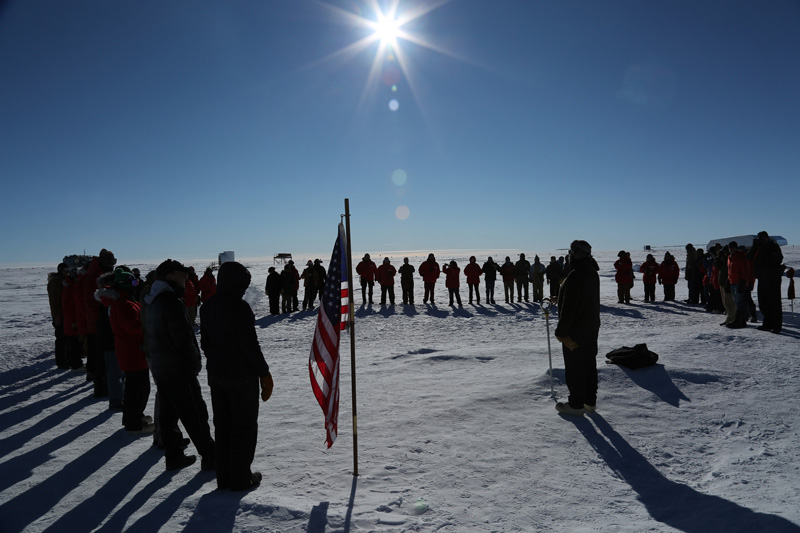
Photo Credit: Christian Krueger
Station residents prepare to pass the flag from the old marker to the new marker
On New Year’s Day at the South Pole Station, residents celebrated with the traditional unveiling of the new South Pole marker. Every year, during the dark months of the austral winter, members of the winter crew design and fabricate a new marker for the geographic South Pole. The marker itself is hidden away and what it looks like is a closely held secret until its official New Year’s debut. Of course it isn’t just a matter of swapping out one marker for another. The station and the pole both sit on a huge chunk of ice about two miles thick, and this chunk of ice is slowly sliding toward the Weddell Sea. Every day the Pole marker moves a little further away from the actual geographic South Pole. Over the course of a year that movement adds up to about ten meters. On New Year’s Day, the new Pole marker – still wrapped in secrecy – was installed precisely at the geographic South Pole. Much of the station population came out for the ceremony, during which the U.S. flag was passed from person to person from the old marker to the new marker. Then, for the first time, the new marker was unveiled for all to see. Now that January is over, the marker (and the rest of the station for that matter) has slid nearly one meter away from the geographic South Pole. This distance will continue to grow, until next year when another marker will be placed once again exactly at the geographic South Pole. January is also a month for those who want to test their athletic prowess. The South Pole Marathon was held on Jan. 1, and six brave souls participated while another six participated in the half marathon. It was a beautiful day, but the wind picked up toward the end of the race, making the finish even more difficult. The month closed out with the South Pole Indoor Triathlon on January 31. Five individuals and three teams competed for the most distance covered after 15 minutes on a rowing machine, 10 minutes on a stationary bicycle, and 25 minutes running up and down the 350-foot station hallway. Also in January, the final South Pole Traverse (SPOT3) arrived at the station to deliver 125,000 gallons of fuel. Collectively, the three traverses this year brought more than 335,000 gallons of fuel to the station. We are grateful for the efforts of everyone involved in the traverse project, and applaud their efforts in travelling all the way to Pole and back to McMurdo. On a more somber note, we were saddened to hear of the passing of Henry Worsley. Henry, a solo adventure expeditioner, passed through Pole in his solo attempt to trek unaided across Antarctica. He was welcomed at Pole, and those that spoke with him remember him as nice, easy-to-talk-to, and positive and upbeat about his journey. Santa's South Pole VisitJanuary 10, 2016
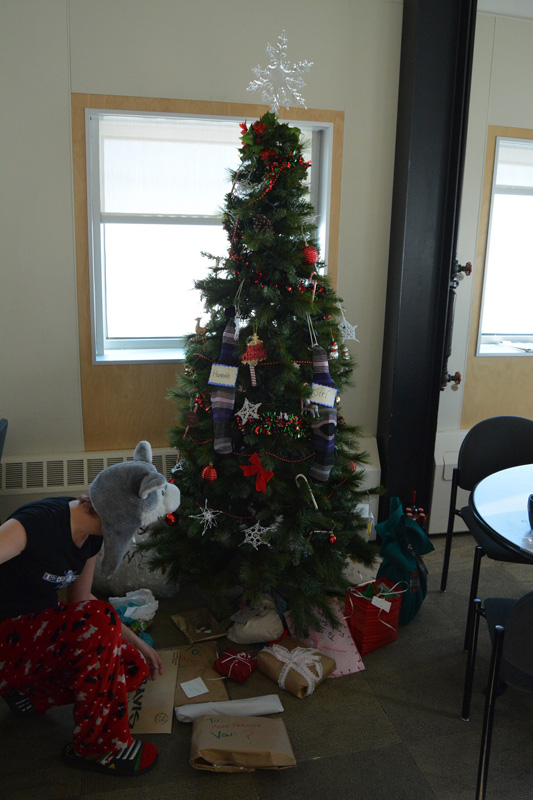
Photo Credit: Ethan Rudnitsky
Secret Santa gifts were placed under the Christmas tree in the cafeteria
Holiday festivities at the South Pole kicked off on December 14th with the first installment of the station’s 12 Nights of Christmas Movies. Screenings of holiday classics, newer comedies and childhood cartoons began setting the seasonal mood. Decorations also sprang up all around the station helping everyone get into the holiday spirit. On Christmas Eve residents held a station-wide Secret Santa gift exchange with presents piled under the Christmas tree in the dining hall. The same evening everyone had the opportunity to get their picture taken with Santa. We were lucky enough to be visited by not just one Santa, but two – a “Good Santa” and a “Bad Santa.” On Christmas morning more than a third of the station participated in the Race Around the World. The annual event is a 2.2 mile fun run where participants “cross through every longitude that the planet has to offer!” It started and finished at the geographic South Pole, and as part of the tradition, many participants showed up in costume. After a light brunch, most everyone relaxed and eagerly awaited the amazing Christmas feast planned for that evening. Highlights of the meal included roasted beef tenderloin with fois gras and passionfruit demi-glace, Cajun butter poached king crab, kikorangi blue cheese scalloped potatoes, salted caramel chocolate tart and cream puffs with raspberry and chocolate sauces. The other big December event at Pole was the First Annual Berming Man – A Work Celebration. In the station’s backyard, there are a number of material storage areas on elevated berms downwind of the Pole. This event was organized to find items that snow had drifted over and start getting rid of a lot of that material. Much of the station lent a hand to dig out buried items and transfer them to new berms, transfer out what is no longer needed, or haul them over to our newest “little” piece of equipment, Fargo the shredder. The workday was followed by a picnic and live music that featured four bands. It was a day of hard work with a fun celebration at the end. December has also seen a big increase in science activity. The station is near its full capacity with grantees and their cargo flying in and out of Pole. Three buildings – the Dark Sector Lab, MAPO and Ice Cube – held open houses to give everyone an opportunity to tour their facilities and get a better understanding of the science that is happening there. The second South Pole Traverse (SPOT2) arrived, bringing with them another 100,000 gallons of much needed fuel to the station. Finally, amid all of this hustle and bustle, there has been a steady stream of tourists flying in to visit the Pole, eager to take some pictures and get a glimpse of what it is like to live and work at the bottom of the world. |
Home /
Around the Continent /
South Pole Station Archives - 2016
"News about the USAP, the Ice, and the People"



For USAP Participants |
For The Public |
For Researchers and EducatorsContact UsU.S. National Science FoundationOffice of Polar Programs Geosciences Directorate 2415 Eisenhower Avenue, Suite W7100 Alexandria, VA 22314 Sign up for the NSF Office of Polar Programs newsletter and events. Feedback Form |

